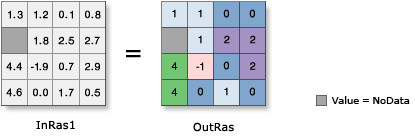Available with Image Analyst license.
Available with Spatial Analyst license.
Overview
Converts each pixel value of a raster to an integer by truncation.

Notes
The input values can be positive or negative.
If rounding is preferred to truncating, add a 0.5 input raster prior to performing the operation.
There is a difference between the Int function and the Round Down function. For example, given the following two values, Int always truncates the number:
- 1.5 becomes 1
- -1.5 becomes -1
- 1.5 becomes 1.0
- -1.5 becomes -2.0.
Another difference is that Round Down outputs floating-point values, while Int only outputs integer values.
Storing categorical (discrete) data as an integer raster will use significantly less disk space than the same information stored as a floating-point raster. Whenever possible, it is recommended to convert floating-point rasters to integer with this function.
If the input is a multiband raster, the output will be a multiband raster. The function will perform the operation on each band in the input.
If the input is a multidimensional raster, all slices from all variables will be processed, and the output will be a multidimensional raster.
Parameters
| Parameter name | Description |
|---|---|
Raster | The input raster to be converted to integer. |
Extent Type | Choose which extent should be used in the output raster:
|
Cellsize Type | Choose which cell size to use in the output raster. If all the input cell sizes are the same, all the options will yield the same results.
|